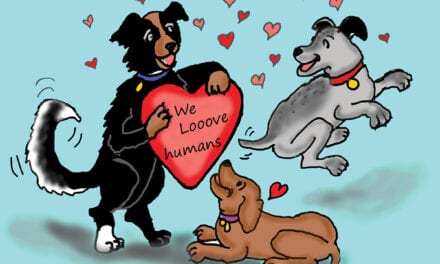
Have you ever tried to converse with someone who doesn’t speak your language? The exchange follows a predictable pattern. First we speak louder—even though deafness isn’t the problem; and then we resort to pantomime to make our message clear. Through a series of hand gestures, exaggerated expressions, and obnoxiously loud pronunciation of whatever words we’ve picked up along the way, we foreigners come across like crazy people. “Who the shoe left beer bathroom?” we ask with a goofy smile, leaving no doubt of our idiocy. It’s the same with the language of dogs. Even though we humans have lived with canine companions for thousands of years, we are no closer to speaking their language than learning to fly.
This inability to understand how to communicate in an unfamiliar language poses obvious problems. It’s simply that we have no idea what we’re saying, and that can be dangerous. For example, we would never—without thorough checking—paste on a billboard a bunch of random Chinese symbols to advertise a product, lest the meaning be lost—or worse still, be an insult. And yet, through advertisements, reenactments, and hours and hours of streaming material, the entertainment industry uses the language of dogs with confidence.
Why is that? I began to wonder. Barking, growling, whining, all can be found in abundance by merely flipping the channels. Since we humans are so oblivious to the language of dogs, where do these producers and animal trainers get their direction? When a dog is trained to “speak” for a part in a role, what is it saying in dog language? My mind began to ponder all these questions when yesterday, our Daisy, who ordinarily ignores the television, whipped her head around at the sound of a dog whining. Did this canine actor say something significant? When the trainer prompted the dog to scratch at the door and whine desperately, did it sound the alarm for help? Daisy certainly thought so. She watched with rapt attention until the scene changed.
“Because we simply cannot grasp their language, dogs have developed ways to let us know their needs without using words at all.”
This pondering lead me to wonder about the made-for-dogs streaming services. Scrolling through the menu, offerings include themes such as ‘Calming’ or ‘Separation Anxiety’ or ‘Happy Dog.’ I’ve certainly tuned in to the calming services, but now that I think about it, how the heck do we or the producers know that it’s calming? It’s not like we humans can screen the curriculum. It advertises a calming effect, and we gladly sign up. There isn’t a translation book that we can scroll through to make sure we like the message. What if it’s pure indoctrination? What if our anxiety-ridden pup is being exposed to a litany of messages in dog language about doubting our return—the opposite of our intent? What if it’s pure gibberish—the dog equivalent to watching “Jersey Shore”—causing our pups to lose respect for our choices?
We’ve all seen those funny videos of dogs ‘talking’ dubbed over with what we humans like to think they’re saying. Hilarious! Of course it’s funny to see a dog speaking like a human. Not so much to see a person barking like a dog. An afternoon spent recording that scene is likely to earn a ride in a Twinkie truck and the fitting of a special backward-closing jacket. Not to mention… if done in the presence of your dog, he is sure to question your intelligence. I don’t recommend it.
When I say I don’t speak dog, that’s not entirely true. I can tell when Daisy is anxious, excited, happy, bored and sleepy. Although I’d like to take credit, this is not because of some insightfulness on my part, but rather how adaptable dogs have become to living alongside us hapless humans, and Daisy in her quest for survival, has joined the club. Because we simply cannot grasp their language, dogs have developed ways to let us know their needs without using words at all. When Daisy thinks it’s time to get up, she lets us know by nudging us while we sleep. If we aren’t responsive quickly enough, she pounces on top of us, poking her wet nose into whatever part of our faces she can burrow into. She didn’t sweep into the room with a cheery “Good Morning! Wakey, wakey!” but the message was clear all the same.
Some understanding between dogs and humans is more nuanced. Recently, when Daisy lunged through the dog door, her demeanor was off. It was a subtle change that held the air of what would best be described as guilt. I picked up on the change right away and went searching for what was amiss. Sure enough, the gate had not been shut properly, and she had ventured off into the great outdoors and had brought back a treasure: a deer skull with a bit of flesh still clinging to the bone. What I perceived as guilt was more like excitement for her solo adventure and hoping we’d let her keep her spectacular find. We didn’t.
It may be naïve, but I think it would be pretty cool if Daisy could talk. In English, so that I could understand her. I imagine her having the voice of Holly Hunter, with a witty, back-talking manner—friend of women and men. Instead of simply poking her nose into what I’m doing in the kitchen by making a pass through and getting a pat on the head, she’d sweep in pulling the cork from a wine bottle with her teeth, steal a bag of chips from the cupboard, plop down on a stool, and be ready to dish. That would make cooking way more entertaining. The downside, of course, would be that if she wanted to go for a car ride, the “are we there yet?” factor could be awful. I survived my own five kids on car rides and don’t wish to revisit that phase. And what if she was foul-mouthed or believed that no quiet moment couldn’t be improved upon with words?
Maybe wishing that my dog could speak—humanizing her—is pure folly. Maybe we should stick to the system in place. Our dogs offer companionship, don’t burden us with unnecessary conversation, and keep us guessing as to what they’d say if they could. So, I don’t speak dog. Maybe that’s the way it’s supposed to be.




